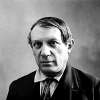Alberto
Giacometti
Alberto Giacometti, a visionary in modern sculpture, is revered for his elongated, surreal figures that embody the existential anxieties of the 20th century. If you’re looking for original Alberto Giacometti prints and editions for sale or would like to sell, request a complimentary valuation and browse our network’s most in-demand works.
Alberto Giacometti art for sale
Discover Alberto Giacometti prints for sale, exclusively available through our private network of collectors. Explore signed and unsigned screenprints, lithographs, digital prints, and rare editioned proof prints by era-defining blue chip artists.
Sell Your Art
with Us
with Us
Join Our Network of Collectors. Buy, Sell and Track Demand
Biography
Born in 1901 in Borgonovo, Switzerland, Alberto Giacometti was surrounded by art from an early age, being the son of Impressionist painter Giovanni Giacometti. This nurturing environment led him to the École des Beaux-Arts in Geneva, and later to the Académie de la Grande Chaumière in Paris, where he honed his craft under sculptor Antoine Bourdelle. Giacometti's early work reflected a fascination with Surrealism, which led him to join the Surrealist movement in the 1930s. During this period, he explored dream-like and abstract forms, but his artistic evolution soon steered towards more figurative and existential themes.
The outbreak of World War II and the subsequent atmosphere influenced Giacometti's shift towards elongated, gaunt figures that have become his signature. His sculptures, characterised by their thinness and textured surfaces, evoke a sense of isolation and introspection, mirroring the anxieties of the era. These works, often rooted in existentialist philosophy, remain some of the most poignant representations of post-war art.
Giacometti's evolution was marked by several key periods. Initially influenced by Cubism and later by the Surrealists, whom he joined in the 1930s, his work took on a more abstract form. However, it was in the post-war period that Giacometti's style truly emerged. His sculptures became known for their raw, gaunt figures that reflect a sense of desolation yet possess a profound human connection. Notable works from this period include Walking Man I and Standing Woman, showcasing his exploration of scale, space, and form.
Throughout his career, Giacometti engaged with a number of artists and intellectuals who influenced his work, including Joan Miró, Pablo Picasso, and existentialist philosopher Jean-Paul Sartre. His friendship with Sartre notably deepened the existentialist themes in his art, mirroring the philosopher's views on the human experience.
Giacometti's works have been showcased in major exhibitions worldwide, and his contributions to art have been recognised with numerous accolades, including the grand prize for sculpture at the Venice Biennale in 1962. His impact on the art world is further evidenced by the record-breaking prices his works achieve at auction, with L'Homme Au Doigt selling for over $141 million in 2015.



























